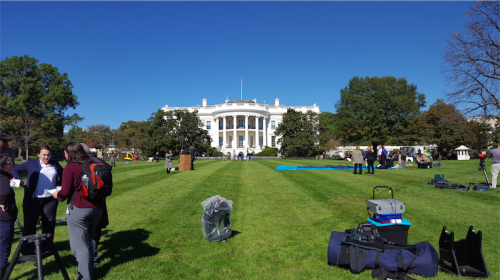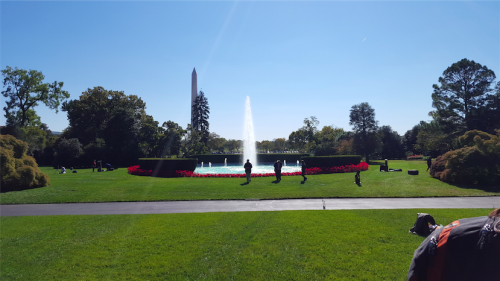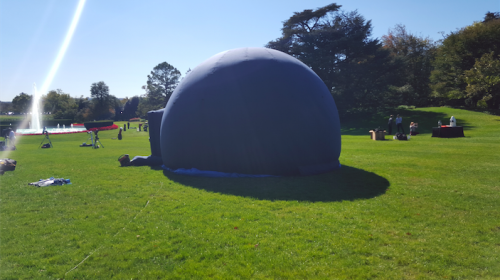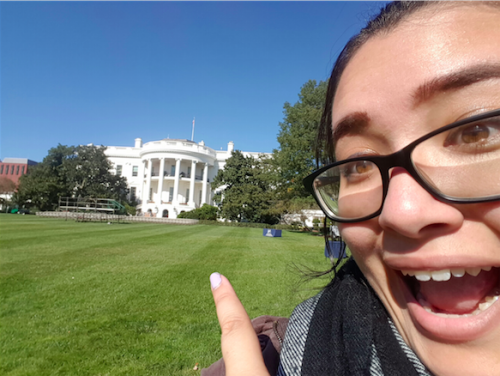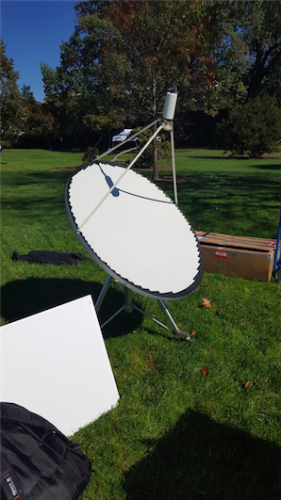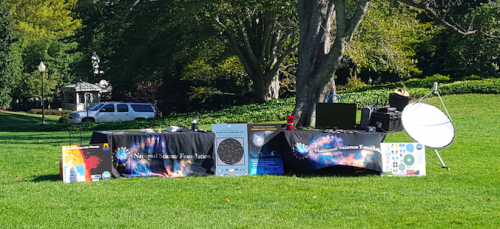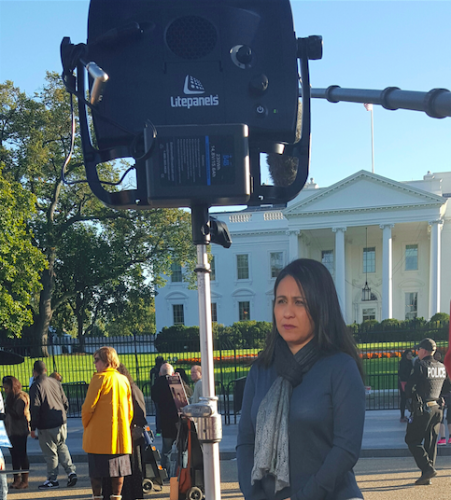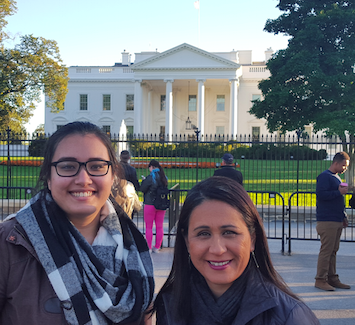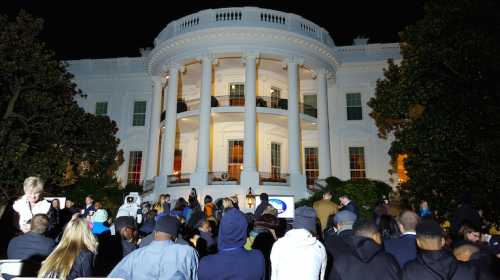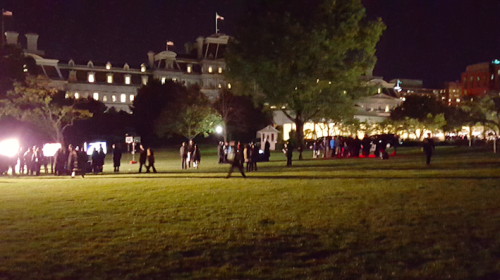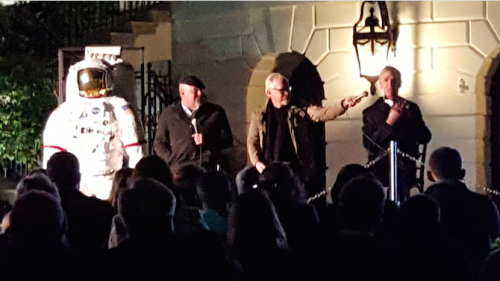- Date: 28 Oct 2015
- Comments: (0)
- Categories: For Everyone, Human Interest
On Monday, October 19th, the White House hosted the second ever Astronomy Night. My name is Alexis Acohido, I’m the current Public Information and Outreach intern at Gemini Observatory, and I was fortunate enough to participate in this event! In addition, I also live-Tweeted from the White House lawn via the Gemini Observatory Twitter account.
Setting Up For the Event
On Monday morning, I made my way to the National Science Foundation (NSF) building to help load and transport equipment. NSF has invested over five billion dollars in ground-based astronomy over the last 20 years, leading to countless major discoveries ranging from exoplanets to the expansion of the Universe, as well as technological advances that span adaptive optics to radio astronomy techniques. NSF provides the majority of the funding for the Gemini Observatory, and also funds the National Optical Astronomy Observatory (NOAO), the National Radio Astronomy Observatory (NRAO), and Associated Universities, Inc. (AUI), all of whom were represented at Astronomy Night.
We made our way to the Northeast gate of the White House at noon and after making our way through security with our equipment, we began setting up the NSF activities booth.
Our booth focused on spectroscopy in astronomy, so we demonstrated various wavelengths of light – from ultraviolet to radio! NRAO even brought a radio telescope to demonstrate radio waves.
Further away from the booths, on a darker part of the lawn, NOAO and AUI set up optical telescopes.
The Kamaʻāina Observatory Experience
In the early afternoon, the White House released a fact sheet about programs that President Obama would mention in his opening remarks – including the Kamaʻāina Observatory Experience. So, at 3:00 pm Ka’iu Kimura from ‘Imiloa Astronomy Center, Bob Kirshner from the Gordon and Betty Moore Foundation, and myself left the White House grounds for an interview session on the new program.
The Kamaʻāina Observatory Experience is a new opportunity provided by the Maunakea Observatories in conjunction with ‘Imiloa Astronomy Center. According to the program’s website, “the Kama‘āina Observatory Experience will provide local residents with an opportunity to visit the summit, see world-class telescopes, and learn about the mountain in a holistic manner.” Residents 16 and older with a Hawai‘i ID will be able to register for free. These guided, monthly tours of the Maunakea telescopes are planned to begin in early 2016!
The Event
Next, we made our way back to the White House lawn and completed some finishing touches as the sun sunk in the west.

One of the NOAO telescopes was pointed at the moon and I was able to take this practice image using the telescope’s eyepiece attachment that was fitted on my cellphone camera!
Around 7:00 pm the President gave his opening remarks. He thanked everyone for coming and announced new Science Technology Engineering and Math (STEM) program initiatives around the country, including the Kama‘āina Observatory Experience. Of the program he said, “Eight observatories in Hawaii will offer all of the residents of that state free, guided tours. They didn’t do that when I was in high school. Wish we had thought that up earlier!”
It’s incredibly gratifying to not only be a part of Gemini, who is one of the sponsors of the Kama‘āina Observatory Experience, but for President Obama to acknowledge the program!
The President also mentioned special guests who were there that evening, they included:
- Senator and former Astronaut Bill Nelson from Florida;
- Science Advisor to the President John Holdren;
- Head of NASA Charlie Bolden and 11 NASA Astronauts;
- Mae Jameson, the first African-American Woman in space;
- Bill Nye the Science Guy;
- The MythBusters (who were gracious enough to let me take a picture with them!)

I got a picture with Adam Savage and Jamie Hyneman from the MythBusters. I didn’t know whether I was shaking because I was star-struck or because the temperature was in the 40’s.
After concluding his brief remarks, the crowd (including children of all ages) broke up into groups visiting the telescopes and booths distributed around the lawn.
Conditions couldn’t have been better that night! There wasn’t a cloud in the sky, and while there’s a good amount of light pollution in DC, we were able to obtain fairly clear images of objects observed through the telescopes.
Groups that came to the NSF booth seemed to enjoy our spectra demonstrations. We used ultraviolet (UV) flashlights and detectors to view the effects of UV light, we also used rudimentary “spectroscopes” to look at emission lines of gases from different gas emission tubes, and finally we featured a radio telescope that guests were able to move and manipulate to pick up radio waves.
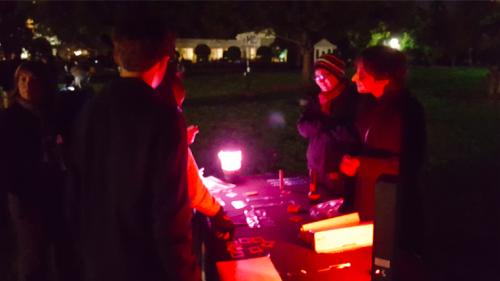
The spectroscopy demos were really great at night! Ivy Kupec and Mangala Sharma from NSF present UV and visible light demos in this image.
I was in charge of running the infrared demonstration. We had television remotes and a camera with a live feed on a monitor. TV remotes give off infrared light (which is invisible to the human eye) when a button is pressed. I then instructed the guests to point the TV remotes into the camera, which was hooked up to a live feed on the monitor. While we couldn’t see the infrared light being emitted from the remotes, the camera was able to detect it and showed a faint red beam of light on the screen! Gemini has two of the most advanced optical/infrared telescopes on our planet, so I was able to segue into the kind of infrared astronomy Gemini does, as well as mention the Gemini telescopes’ unique silver mirror coating that allows us to take better quality infrared observations.
At the end of the night, the guests were treated to a question and answer session from the MythBusters and Bill Nye the Science Guy while we broke down our booths.
Overall the event was fantastic. It was a very rewarding experience for me to promote the astronomy that’s being done in Hawai’i and Gemini in particular. It’s also very encouraging to have a President who is willing to put such an emphasis on STEM education.

